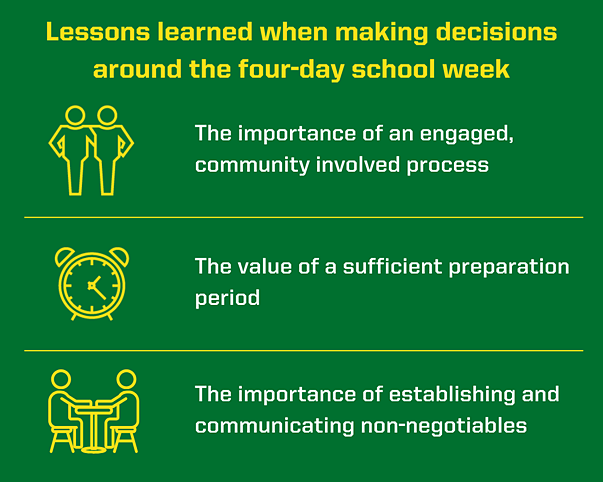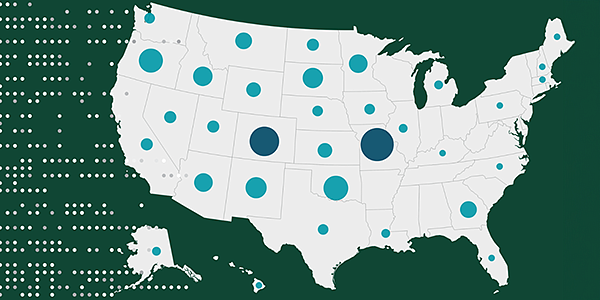By Emily Tomayko, Assistant Professor, Montana State University, Katherine Gunter, Professor, Oregon State University, and Paul Thompson, Associate Professor and Associate Director - Economics, Oregon State University
Bringing researchers and practitioners together can foster collaborations that spark innovation, improve practices, and better align the questions researchers ask with the solutions practitioners need. A conference at Oregon State University brought researchers studying four-day school week (4DSW) policies and practices together with school practitioners implementing 4DSW schedules.
The two groups met to learn from each other and work collaboratively to address three goals:
- Raise awareness regarding the benefits and challenges of the 4DSW schedule and highlight innovative 4DSW implementation practices.
- Learn about how, and to whom, research outcomes and practice-tested implementation strategies are communicated to advance research and inform practice.
- Develop a better understanding of the needs of administrators to improve future 4DSW research.
Pause for perspective: What to consider before adopting the 4DSW schedule
Superintendents serving both rural and non-rural districts shared their experiences adopting and implementing the 4DSW. Most administrators favored the 4DSW, often citing teacher recruitment and retention benefits (although there is limited research evidence addressing these outcomes). Administrators also noted that 4DSW student-athletes missed less instruction time due to long travel distances associated with competitions. Administrators representing rural areas also discussed the benefits of a weekly “day off” to allow families and staff greater opportunities to travel long distances for medical or personal appointments.
Administrators shared several lessons learned:
- The importance of undertaking an engaged, community -involved process when weighing the pros and cons of 4DSW adoption.
- The value of a sufficient preparation period before making any decisions about 4DSW implementation, to allow for communication and problem-solving with families and staff.
- The importance of establishing and communicating non-negotiables, such as things that must change with a shift to 4DSW (e.g., daily instructional hours) and things that cannot be changed (e.g., state-mandated minimum instructional hours).
Administrators encouraged those considering 4DSW adoption to explore various 4DSW models and carefully assess the impact of a change on instructional time, curriculum, off-day programming, food provision, physical education, extracurricular activities, childcare options, and other factors. Different communities will prioritize different factors, so engagement is a vital step in the process. Finally, administrators suggested that those interested in adopting the 4DSW should seek counsel and learn from those who have already navigated the process.

One size does not fit all: 4DSW implementation strategies
Administrators and researchers also discussed key considerations for 4DSW implementation, including:
- optimizing instructional time
- offering diverse programming on off-days
- addressing food provision needs
- adjusting homework practices
- enhancing physical activity opportunities
- supporting extracurricular activities
- expanding childcare options.
Discussions also centered around off-day programming, as it plays a crucial role in the success of this schedule, providing students with enriching activities and opportunities for learning outside the traditional classroom setting.
Researchers and superintendents also discussed how after the schedule is adopted, implementation assessment should involve regularly utilizing parent satisfaction surveys, staff feedback, and community input. Leadership should align success metrics with community values, and factors like staff retention, graduation rates, academic performance, and social-emotional learning aspects. Administrators shared that based on their experience during implementation, districts should expect the unexpected and monitor changes in multiple outcomes, including educator recruitment and community perception.
Cultivating relationships between researchers and practitioners
Researchers and practitioners at the conference all expressed interest in assessing the 4DSW and its potential impacts on outcomes, including teacher, student, and family health and well-being; teacher retention; funding; and student achievement.
Although interests between researchers and practitioners often aligned, practitioners also reported skepticism of 4DSW research efforts, which may be due to the perception of researchers’ lack of understanding of school districts’ contexts or institutional details behind what can be gleaned from data alone. Researchers hoping to make their work more impactful can focus on clear communication and transparency about research intentions and outcome expectations to help minimize this skepticism.
The conference also highlighted a best practice for connecting research and policy: bringing together researchers and administrators to promote ongoing conversations and disseminating findings back to school districts in relevant ways. Trusted relationships between researchers and educators will help ensure that research is relevant and is disseminated through channels that allow practitioners to learn from the research, make informed policy decisions, and implement proven strategies, and share back questions and ideas that may spur future research.
More about the conference
The conference was sponsored by the Spencer Foundation and held over two days (October 20-21, 2023) at Oregon State University in Corvallis, Oregon. On day 1, researchers shared recent data exploring the effects of 4DSW implementation on various outcomes, and 4DSW superintendents from six states highlighted implementation successes and challenges. On day 2, researchers and practitioners discussed strategies to advance 4DSW research and improve practice in a series of guided discussions following a World Café model.
Who are active researchers in the field and how can I learn more about their work?
Presenters included Paul Thompson, Kathy Gunter, Emily Tomayko, John Schuna, Emily Morton, Rebecca Kilburn, and Jon Turner. Much of their research, and the research of others focused on 4DSW can be found on the HEDCO's Four-Day School Week Research Database.
Explore more:


Want more from the HEDCO Institute: Sign up for our emails!
HEDCO Institute article 23 - July 23, 2025

